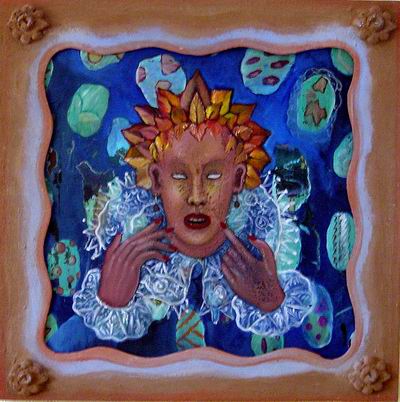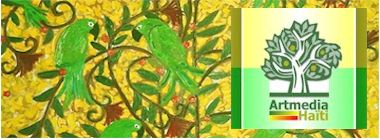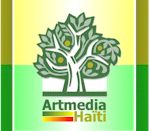|
Femme Rossignol
I personally believe that most artists are in one way or another reflections of their immediate surroundings.
 |
- What they are confronted with on a daily routine is bound to affect and influence their personal visions of the world. This general tendency would simplify my answers to inquiries on the relative importance of popular culture in the context of the contemporary art world. But with the advent of a rapid globalization and the proliferation of information at all levels, this permits everyone, and particularly artists, to take their ideas from a global well. - EDC
Artist Interview - Edouard Duval Carri�
by Latin Art
LatinArt: How did you first become interested in incorporating popular/folk elements into your work?
Duval Carri�: I personally believe that most artists are in one way or another reflections of their immediate surroundings. What they are confronted with on a daily routine is bound to affect and influence their personal visions of the world. This general tendency would simplify my answers to inquiries on the relative importance of popular culture in the context of the contemporary art world. But with the advent of a rapid globalization and the proliferation of information at all levels, this permits everyone, and particularly artists, to take their ideas from a global well.
This phenomenon is particularly well exemplified in the music world, where artists in the medium find it quite exhilarating to plunder the millennia of musical data from the global village and rehash it into quite surprising -new- creations. The same applies to the visual art world that is seeing, and justly so, its preconceived barriers and standards tumbling one after another. Regionalism, concepts of center vs. periphery, high and low art, are all ideas that are being reassessed due to the pressure exerted by a constant input of visual reference to larger and larger numbers of individuals that in turn reappraise these references in ways not initially intended.
Of concern to me was my proximity to a culture that was relatively inaccessible even to me, who am from the region. I'm talking about the popular expressions of Ha�ti, which though quite complex, are summed up in the mystifying word of Voodoo. Though the cultural pattern is quite similar to many Latin American societies, Ha�ti has been singled out as an oddity. And an oddity it might be, because its early history and subsequent isolation created patterns that are deeply rooted in old African concepts and world-views. Those are part of what I've been looking at in my work and hopefully render less cryptic. My position as an artist has permitted me to look both from within and without a situation that to most seems fraught with ambiguity and negativity, to say the least. But it is part of the global picture, and to remind others of its existence, if only in art, serves to accentuate the pressures that only visual experiences can offer. I'm only partaking in a tendency that seems to be global in intent, for this
pattern is seen not only in Latin America but also in Africa and certainly in Asia. Cynics have attributed this solely to an economic agenda, but looking at the phenomenon closely puts in evidence a genuine attempt to reach a certain consensus in plurality; at least a certain coexistence.
LatinArt: What is your opinion about how our notion of what is -high- and -low- art has now become more ambiguous and increasingly interchangeable than in the past?
Duval Carri�: The notions of north and south, far and near, high and low, in and out are constantly being reevaluated, for such notions do painfully exist. It is undeniable that pervasive concepts such as the one of -high- culture are being questioned if not reassessed as convenient marketing ploys. In today's short attention span world, refinements of the effort seem to be superfluous if not totally out of sync. Artists find themselves with freedoms they never thought possible, but in the end they are left much to their own device to interpret their worlds. Traditions and folk-ways seem to come in handy at such times, and we find many artists appropriating the language of popular culture in order to elaborate their creative construct.
In doing so, mechanisms that are used in the elaboration of what is considered as popular culture find their way into art forms that sometimes can only be read because they contain these elements, making those art forms more accessible if only to the ones familiar with those cultures. Ultimately, folk-ways and popular imagery have this resilient quality that makes them enduring facets of any given culture.
LatinArt: How will these changes continue to affect the future of contemporary art in Latin America, a region with a long tradition (both past and present) of popular/folk art?
Duval Carri�: Many scholars claim that with the advent of globalization, artists (whether they are from the suburbs of Lagos, Kuala Lumpur or Lima) have enough information at their disposal that enables them to create within what is defined as a -contemporary- format. To me, this seems a just conclusion, but somewhat amiss of reality - yes, artists having access to this global net can partake in a creative process governed by such rules, but the global configuration is far from being an all-inclusive one. The sad truth is that a much larger portion of the globe's population can be counted as -out,- and thus governed mainly by an amalgam of the culture that is based in folk ways and traditions, in turn producing or evolving into popular cultures that in turn influence us artists. To me, this situation is a more just assessment of reality today, though reflective of serious inequalities and injustices, and ultimately, a more salutary situation then the one envisaged in the bland utopia of the global village.
Artist Interview - Edouard Duval Carri�
by LatinArt.com
http://www.latinart.com
- Edouard Duval-Carrie
- Size: 30x30 Framed
- Medium: Acrylic
- Support: Canvas
- For Sale by Private Collector
|



